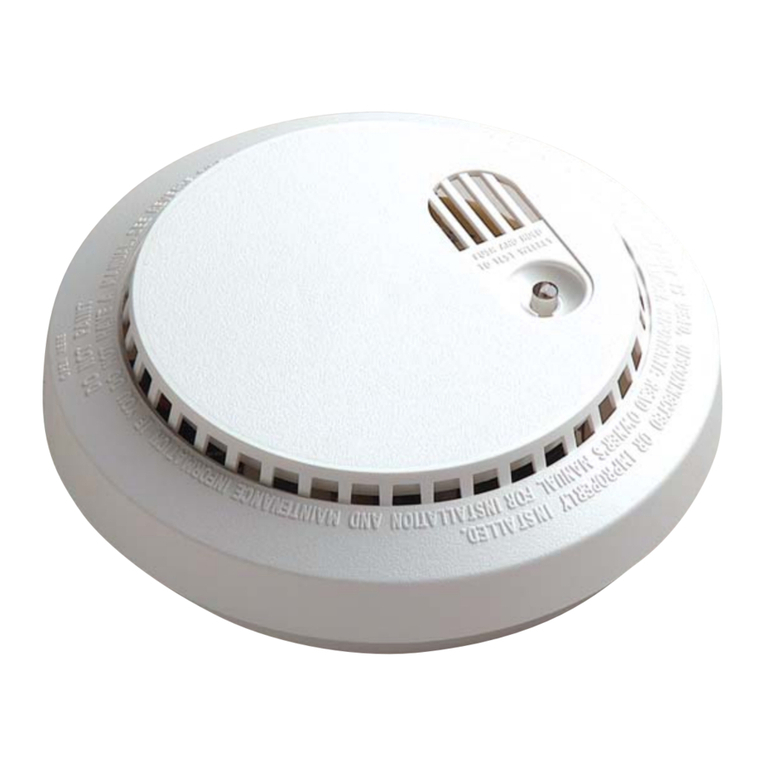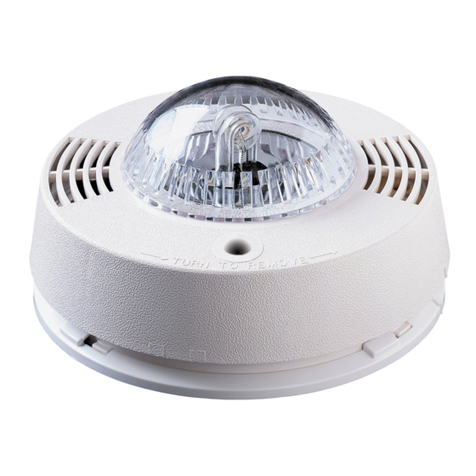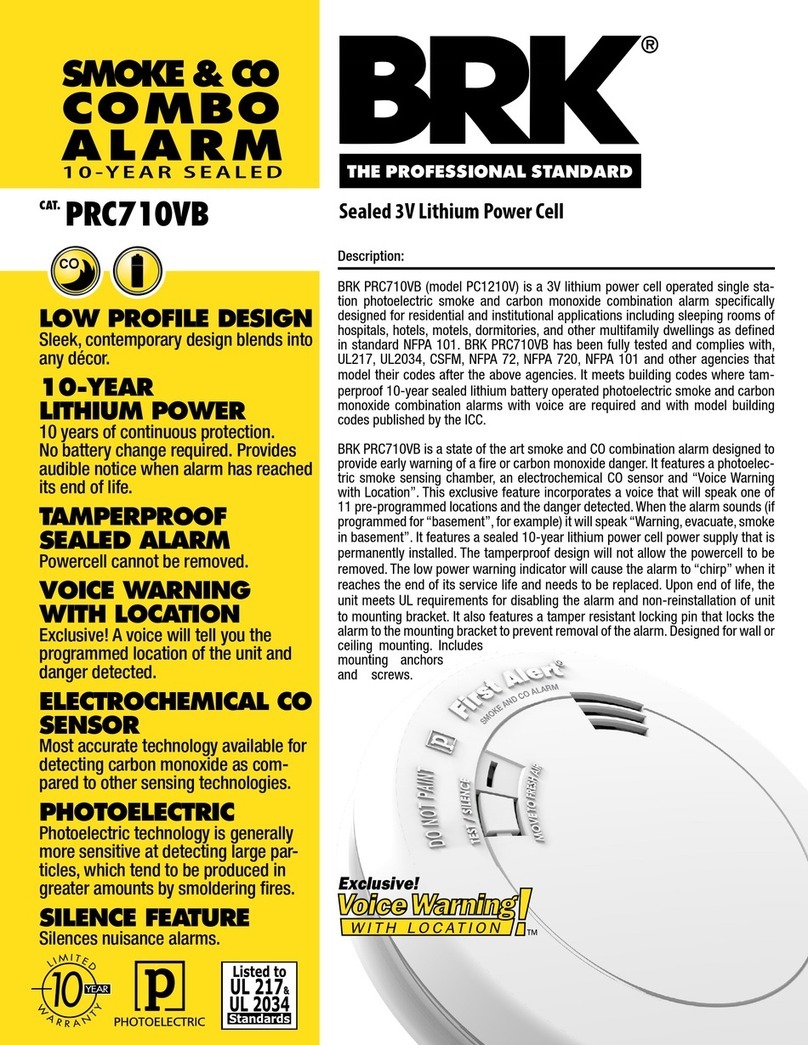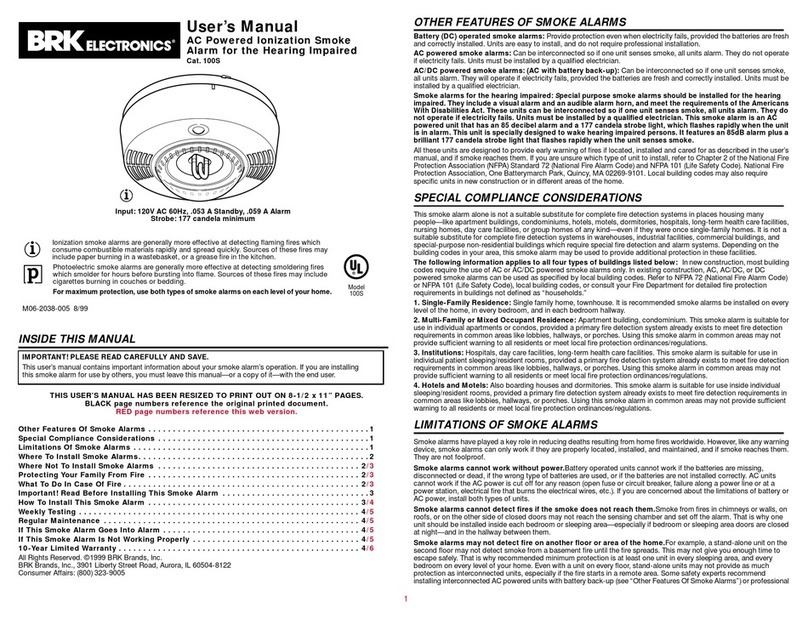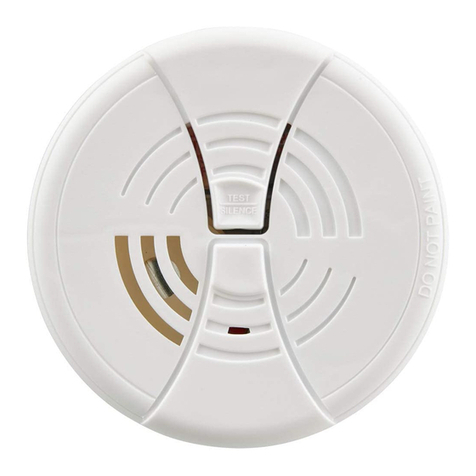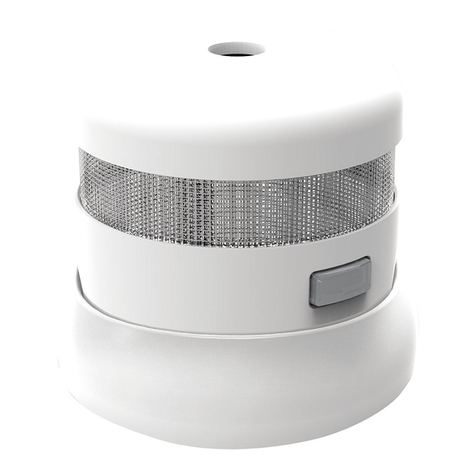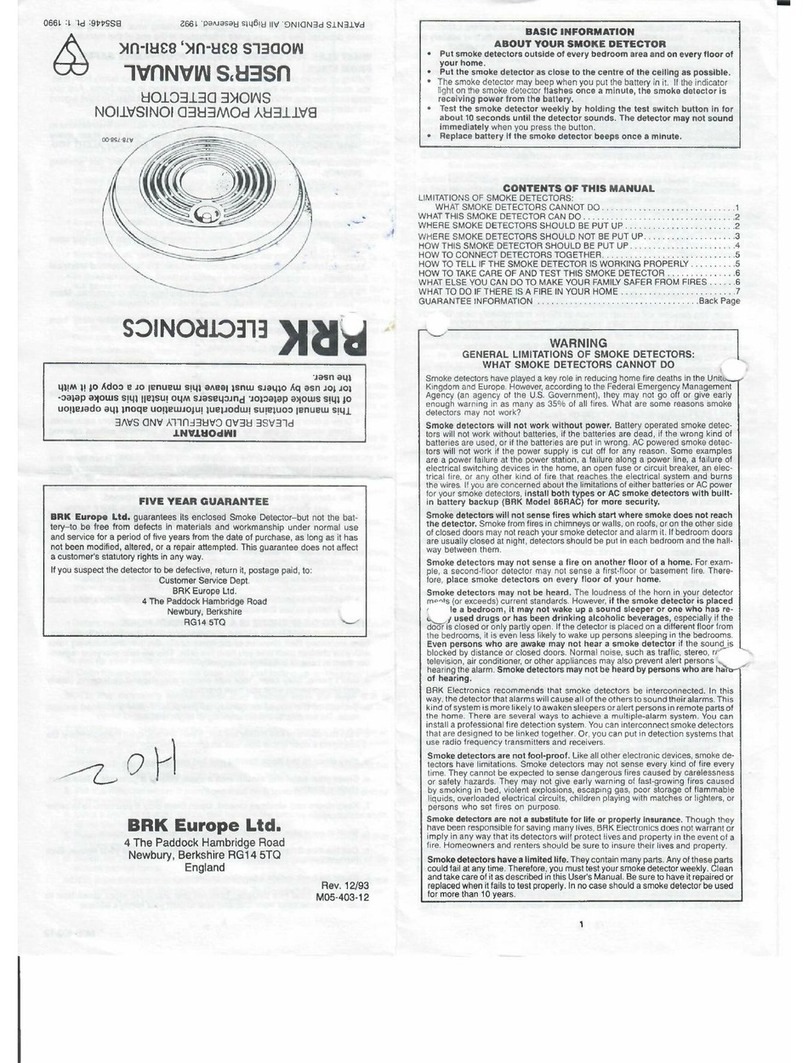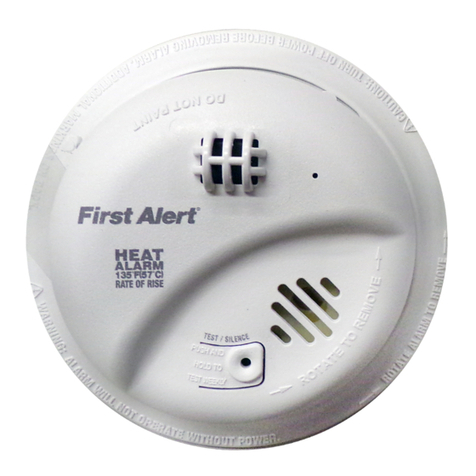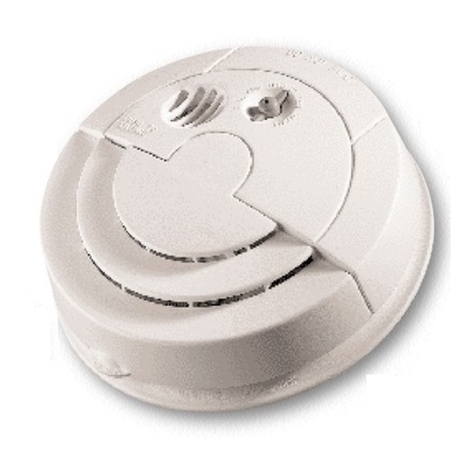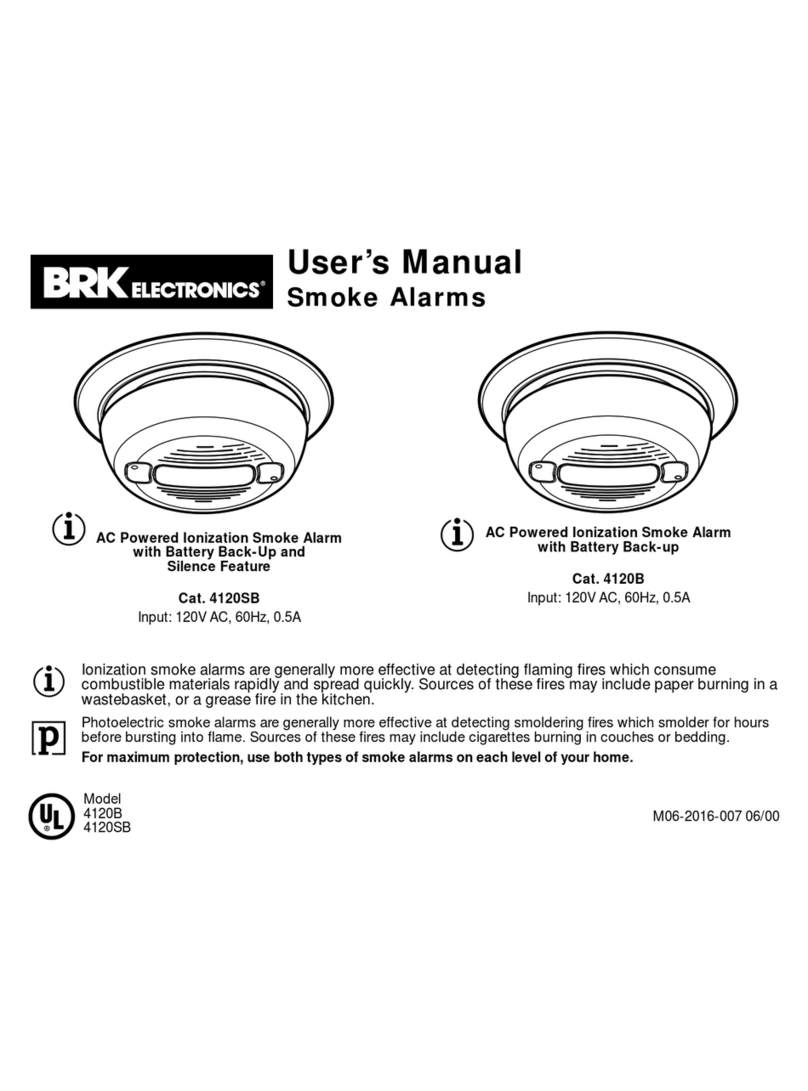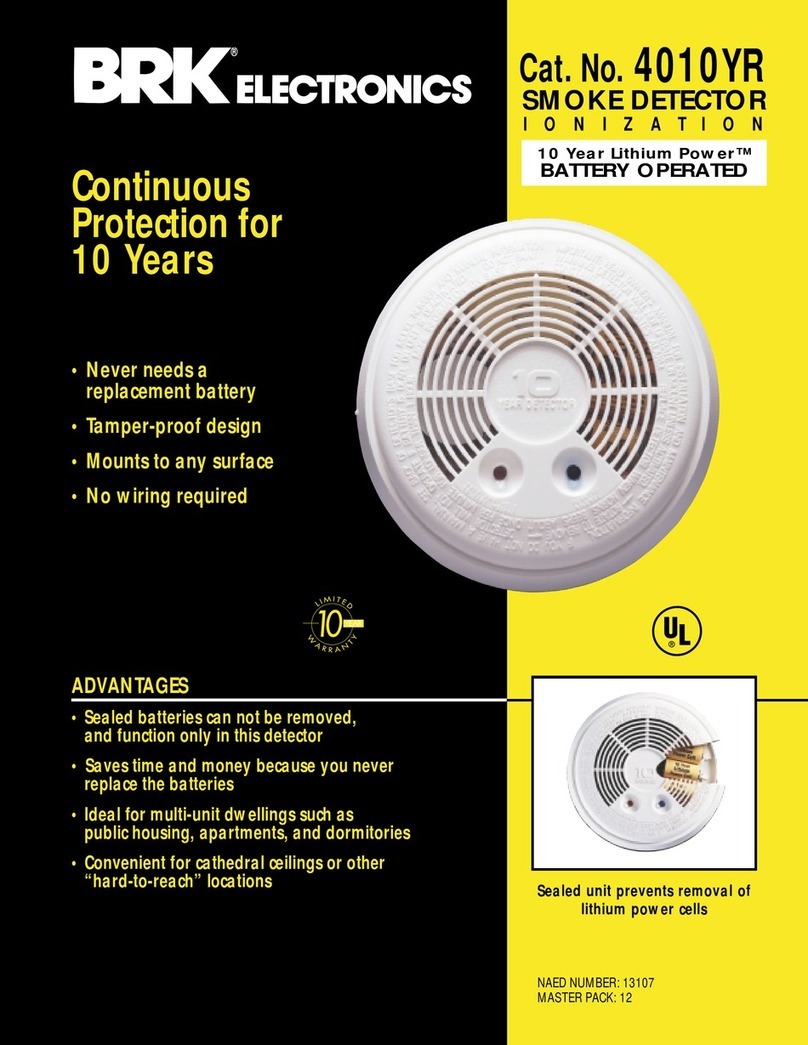
Caravan Holiday Home
1. The preferred position for fitting the smoke alarm is horizontally on the ceiling in the living area.
Avoid proximity to the kitchen
2. An additional smoke alarm may be fitted in one or more bedrooms.
3. DO OT locate in kitchen or bathroom area. Cooking fumes and high humidity can trigger nuisance
alarms.
4. DO OT locate smoke alarms close to exhaust fans or air conditioning units, which could draw
smoke away from the alarm.
Park Homes
1. If only one smoke alarm is to be fitted, it should be located horizontally on the ceiling, either in the
living room or the hall, but not in the proximity of either kitchen or bathroom.
2. Additional alarms can be fitted in bedrooms.
3. DO OT locate alarm close to exhaust fans or air conditioning.
INSTALLATION
1. Open the cover and handle unit with care to avoid damage.
2. Locate keyhole slots.
3. Mark holes through alarm base. Then remove alarm. Drill two 4.75mm holes.
DO OT drill with alarm still in position as this will contaminate the unit with dust.
4. Insert the plastic anchors. Screw alarm base to mounting surface.
NOTE: When wall mounting a unit, ensure that the keyhole fixing slots are positioned with the narrow
aperture uppermost, to prevent the unit from being dislodged.
For interconnect units only (Models with the suffix i, eg 300i SA900i)
5. Using standard figure eight twin solid core bell wire, connect like to like, i.e. Positive terminal block
to positive terminal block, negative to negative.
OPERATION: HOW TO TEST
1. Connect battery(ies). For models with the suffix S (eg SA900Si), the battery is already connected.
Remove activation tab.
Storage in low humidity, and certain transportation conditions, may cause electrostatic charges to build
up in the alarm system housing. Although harmless, they may increase the length of time that the horn
sounds upon battery insertion or test button operation. The condition may be cleared by gently wiping
the inside and outside of the plastic cover with a clean, damp cloth.
2. Check LED operating light flashes approximately every 45 seconds in standby mode.
3. Depress and hold test button until alarm sounds. ote: It may be necessary to depress test button
for up to 20 seconds for alarm to sound. Alarm is indicated in a loud 3 beep pattern. Alarm may
continue for up to 10 seconds after button is released .
After installation:
1. Press test button until alarm sounds, then release. Repeat test weekly.
WARNING: The electronic test button provides a full test of the unit’s functionality. DO OT try to test
the alarm with a naked flame, as this may present a potential fire hazard in itself.
For interconnect units only (Models with the suffix i, eg 300i)
2. Test each alarm separately in the system.
3. Determine that initiating alarm triggers all other alarms.
BATTERIES
Your alarm requires one 9 volt battery to power the smoke detector portion of the unit. Recommended
batteries are: GP 1604A or GP 1604P, Duracell M 1604 or MX1604, Eveready 1222. Under normal
use, the battery powering the smoke alarm should last approximately one year.
SA900, SA900Si & SA300L
Your SA900, SA900Si & SA300L Smoke Alarms come complete with a Long Life Lithium Powercell.
In the SA900Si the battery is not replaceable. Do not remove this battery from the alarm. Under normal
use and conditions the U9VL Lithium Powercell guarantee is 10 years, the typical life of the alarm. The
U9VL Lithium Powercell is the only acceptable battery for this smoke alarm. When the U9VL Lithium
Powercell reaches the end of its normal life, a low battery warning (intermittent beeping, for at least 30
days) will indicate the need for U9VL Lithium Powercell replacement and in the case of the SA900Si,
complete smoke alarm replacement.
IMPORTANT: Test alarm using test facility whenever battery is replaced.
SIMPLE MAINTENANCE
Vacuum every six months to help keep the unit working efficiently. Open cover and gently vacuum
interior of detector. Keep vacuum nozzle from touching the unit.
Problems are indicated by two events:
1. The alarm does not sound upon pressing the test button.
2. The operating light remains steadily on or off. (i.e. does not flash approximately once every 45
seconds, when the unit is not in alarm).
TRY THE FOLLOWING:
1. Inspect for obvious damage.
2. Visually check that unit contains recommended battery type.
3. Check that battery is properly connected.
4. Gently vacuum as recommended above.
5. Replace battery.
If these procedures do not correct the problem, do OT attempt repairs. If the smoke alarm is within
warranty period and terms, indicate the nature of the problem and return the unit with proof of purchase
to distributor. Units beyond warranty cannot be economically repaired. For address see back page.
FALSE ALARMS
Abnormal air conditions may cause the highly sensitive smoke alarm to give a ‘false’ alarm. DO OT
DISCO ECT THE BATTERIES. If no fire is apparent, ventilate the room and/or operate Alarm Pause.
WARNING: IF THERE IS A Y QUESTIO AS TO THE CAUSE OF A ALARM, ALWAYS ASSUME THAT
THIS IS DUE TO A ACTUAL FIRE A D FOLLOW YOUR FIRE EMERGE CY PLA S. Do not assume the
alarm is a nuisance alarm and press the test button to activate Alarm Pause.
Dust can have an adverse effect. Vacuum as recommended above.
Do not paint the unit.
Other factors such as nicotine and insect contamination may also adversely affect the alarm.
LIMITATIONS OF SMOKE & HEAT ALARMS
Quality smoke & heat alarms are designed to provide the earliest possible warning of fire and smoke
at reasonable cost. Early warning can mean the difference between a safe escape and no escape at all.
Alarms do, however, have limitations.
Alarms cannot work without power. Battery operated alarms will not work without proper batteries, with
dead batteries or if batteries are not properly installed. AC powered alarms will not work if their AC power
supply is cut off by an electrical fire, an open fuse, a circuit breaker or any other reason. If you are
concerned about the reliability of either batteries or your AC power supply for any of the above reasons,
you should install both battery and AC powered smoke alarms in your home, or mains powered
smoke alarms incorporating a back up power source. (In the event of an AC power failure, alarms
with battery or capacitor back up will only work for a limited period, such period being dependent
upon the condition of the standby battery or the retained charge in the standby capacitor).
Alarms are incapable of sounding the alarm until smoke or heat reaches the sensing chamber.
Anything preventing this from reaching the detector, such as a closed door, may delay or prevent an
alarm. A smoke alarm cannot detect fire in the walls, chimney or roof unless and until a significant
amount of smoke reaches the alarm. An alarm on any given floor should not be relied upon to detect
fire on any other floor. For these reasons a smoke and heat alarm should be installed in every
room or at least on every level of your home.
Smoke and heat alarms may not provide protection for a smoker smoking in bed, for children playing
with matches, or for violent explosions resulting from escaping gas. Installation of smoke & heat
alarms is only part of a complete home fire safety programme.
BRK Dicon and First Alert smoke & heat alarms are manufactured to the highest standards to ensure
faultless operation and long life. The manufacturers do, however, recommend that no alarm should be
used for more than 10 years, in order to minimise the chance of a fault occurring.
Your smoke and heat alarms are not a substitute for property, disability, life, or other insurance of any
kind. Appropriate insurance coverage is your responsibility. Consult your insurance agent.
RADIOACTIVE CONTENTS
The units in the BRK Dicon Micro 300, SA900 & First Alert SA300, SA200 ranges of ionisation smoke
alarms utilise a tiny amount of radioactive material, 0.9 microcuries (33 kilobecquerels) of Americium
241, to detect smoke. This material is in the form of a sealed source and represents no hazard
whatsoever to anyone installing or using the smoke alarm. Any stray particles would be unable to
‘penetrate through the dead layer of skin and thus do not constitute an external hazard.’ (Radiation
Protection Guidance for Scientists and Physicians). All BRK Dicon/First Alert ionisation smoke alarms
have been rigorously tested by the ational Radiological Protection Board to ensure absolute safety.
2502-B0001_M300&SA900_GB MANUAL.qxd:2502-B0001_M300&SA900_GB MANUAL 16/9/09 09:25 Page 2
